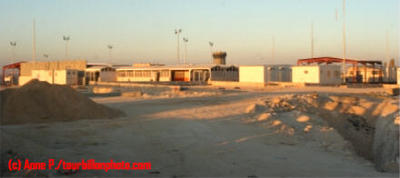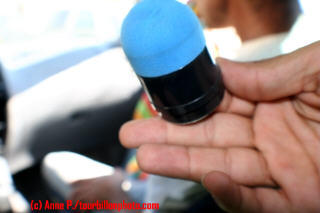Pour aider Ziyad, un defenseur des droits humains arrete par l'armee israelienne (voir cas dans post precedent), vous pouvez envoyer une lettre sous le modele suivant.
To help Ziyad, a human rights fieldworker, who has been arrested by the Israeli army, you can use the model letter as followed.
Tzipi Livni (Ms) Minister of Justice Ministry of Justice 29 Salah al-Din Street Jerusalem 91010, Israel
Menahem Mazuz (Mr) Attorney-General/Legal Advisor to the Government Ministry of Justice 29 Salah al-Din Street Jerusalem 91010, Israel
Brigadier General Avihai Mandelblit Chief Military Attorney 6 David Elazar Street Hakirya Tel Aviv Israel
17h June 2005
Dear Minister,
I was disturbed to hear of today’s decision by the Moscobiya Military Court to place Ziyad Muhammad Shehadeh Hmeidan in administrative detention, for an indefinitely renewable period of six months. Administrative detention is the imprisonment of individuals without charge or trial by administrative rather than judicial procedure. Ziyad, 31, lives in al-Khass village near Bethlehem, and has been a fieldworker with human rights organisation Al-Haq since 2000. He is responsible for monitoring and documenting violations of international human rights and humanitarian law in the Bethlehem area of the Occupied Palestinian Territories (OPT). No formal charges have been brought against him, nor has the evidence supporting his detention been made available to his lawyer. Despite this, Ziyad was issued with an administrative detention order today in violation of his fundamental rights under international law, in particular the right to due process.
Ziyad was detained on 23 May 2005 at the Qalandiya checkpoint between Ramallah and Jerusalem, while on his way back to Bethlehem from Birzeit University where he is a postgraduate student. Ziyad has now spent 25 days in detention without any formal charges being brought against him, and without being informed of the reasons for his detention. Furthermore, the Israeli authorities have taken measures to inhibit and deny his access to a lawyer. This was done by moving him between different detention facilities and then (through an order issued in a hearing on 30 May) preventing his access to counsel for eight days. This order, and indeed his subsequent administrative detention, has been justified by “security reasons”, which have not been disclosed to Ziyad or his legal counsel.
Article 9 of the International Covenant on Civil and Political Rights (ICCPR), to which Israel is a State Party, guarantees to everyone the right not to be subjected to arbitrary detention. It also gives everyone the right, if arrested, to be promptly informed of the reasons for the arrest and of any criminal charges. While Israel has derogated from its obligations under this article, the UN Human Rights Committee has made it clear in its 1998 periodic review of Israel’s compliance with the ICCPR, that a State party may not depart from the requirement of effective judicial review of detention. Specifically, according to the Committee, a detained person must be informed promptly of the reasons for detention and must be allowed access to a lawyer within 48 hours of the detention. Moreover, administrative detention must be of a short duration and can not be for an indefinite period.
In addition, the right to a fair trial is guaranteed under international humanitarian law. The legal principle that no one may be convicted or sentenced, except pursuant to a fair trial affording all essential judicial guarantees, has been deemed customary by the International Committee of the Red Cross. Ziyad’s treatment does not conform to these obligations.
I am compelled to highlight that Ziyad’s situation is not unique. Addameer (a support and human rights organization of Palestinian prisoners) estimated that at the end of 2004 there were over 850 Palestinian administrative detainees in Israeli prisons. Further, Israel’s widespread and sustained policy of administrative detention is supported by both the government and the judiciary, denying Palestinian detainees any meaningful protection of their rights.
I believe that the Israeli policy of administrative detention violates international human rights and humanitarian law. In the absence of clear charges being brought against Ziyad Hmeidan, I demand his immediate and unconditional release.
Yours,
Chroniques d'une photographe,specialiste des droits humains en Palestine et ailleurs, Chronicles of a French photographer, specialist in human rights, in Palestine and elsewhere
Saturday, July 30, 2005
Wednesday, July 27, 2005
Defenseur des droits humains de l'organisation al haq en prison/ Al Haq's fieldworker in prison
Dessous, information en anglais sur l'arrestation et la detention de Ziyad un des correspondants locaux de Al Haq, qui a ete arrete en mai. Zyad travaille pour al haq depuis 5 ans, il a deux enfants en bas age. Il a ete mis en detention administrative- une procedure employee par les Israeliens par laquelle ils emprisonnent de nombreux Palestiniens sans aucun chef d'accusation. La seance de son audience a ete avance d'un jour et ainsi le personnel de Al Haq n'a pas pu y assister. Zyad a ete transfere dans un centre de detention dans le desert de Neguev repute pour des conditions de detention deplorable.
Merci d'ecrire pour demander sa remise en liberte aux autorites israeliennes
Al-Haq Fieldworker Ziyad Hmeidan in Administrative Detention.
On 23 May 2005, Al-Haq fieldworker Ziyad Muhammad Shehadeh Hmeidan wasdetained at Qalandia checkpoint. Since his detention, Al-Haq has beenfollowing his situation closely and has attempted to secure his release andensure he is not subjected to ill-treatment or torture.Ziyad, who has worked for Al-Haq for five years, was detained on 23 May,around 16.30, while crossing Qalandia checkpoint. Al-Haq learned of hisdetention when two Al-Haq staff members passed through the checkpointseveral hours later and discovered him handcuffed by the checkpoint. Ziyadtold them that he had handed over his ID (#999602097) to Israeli forces, whoran the number through a computer, and then took him aside and handcuffedhim. Ziyad was able to speak to the Al-Haq staff members for about half anhour, after which Israeli soldiers removed him to a small room, ostensiblybecause it was getting cold.Initial contacts made by Al-Haq suggested Ziyad might be taken to Beit ElDCO. However, two days later, Al-Haq learnt that he had initially beentransferred to an open-air facility, believed to be part of the Atarot IDFfacility, and had then been transferred to Etzion detention centre.At Etzion detention centre, Ziyad was able to communicate with lawyers fromother human rights organisations visiting the prison. Through them, Al-Haqlearnt that Ziyad had not been subjected to any physical abuse, and had beeninterrogated for around two hours on 24 May on subjects unrelated tosecurity or political issues, such as his marital status. At that time, Ziyad had been informed that he would have a hearing on 31May, which several staff members from Al-Haq planned to attend. However,Al-Haq subsequently discovered that Ziyad had first been transferred to theEast Jerusalem Moscobiyya interrogation centre, also known as the RussianCompound, on May 27 and had been interrogated there for approximately threedays. Al-Haq then learnt that the hearing, which was scheduled for 31 May,had taken place a day earlier, thus preventing any staff members fromattending.At the hearing, Ziyad's detention was extended for a further 18 days. Soonthereafter an "Order Prohibiting Meeting with Counsel" was also issued for aperiod from 13.30 on 30 May until 23.59 on 5 June. The order, which has its legal basis under Israeli law in Military Order 378of 1970, is in contravention of international legal protections safeguardingthe rights of detainees. While Israel has derogated from its obligationsunder Article 9 of the International Covenant on Civil and Political Rights,the UN Human Rights Committee made it clear in its 1998 periodic review ofIsrael's compliance with the treaty that a detained person must be allowedaccess to a lawyer within 48 hours of the detention.Upon learning about the hearing, Al-Haq employed the services of Israelilawyer Leah Tsemel, who has extensive experience defending Palestiniandetainees. Despite the order preventing Ziyad access to a lawyer, Leah wasable to meet Ziyad on 5 June. She reported that he was in good health andhad not been subjected to ill-treatment or torture. Her office submitted anappeal for Ziyad's release, on the grounds that no charges had been broughtagainst him. While Leah was able to meet with Ziyad, two Al-Haq lawyers weresubsequently prevented from doing so, ostensibly because they were not hislegal representatives.The appeal for release was heard on 14 June, at Ofer military court. At thattime the prosecution submitted classified information, which Ziyad's counselwas not permitted to see. On the basis of that evidence the judge dismissedthe appeal and a hearing on the extension of Ziyad's detention, which wasdue to expire in two days, was scheduled for 16 June.Initially, Al-Haq was informed that Ziyad's detention had been extended fora six-month period by a military court on 16 June. However, Al-Haqsubsequently learnt that the Deputy Military Commander of the West Bank hadordered the extension, and that the order would be considered before amilitary court later in the month. The hearing on the order was held on 28 June and the order was confirmed.The judge stipulated that the time Ziyad had spent in detention should counttowards the six months of detention. That means Ziyad cannot expect to bereleased before 23 November of this year, and his detention may be extendedbeyond that date. On July 3rd, Ziyad was transferred to Ansar III prison. The prison, locatedin the Negev Desert, is little more than a series of tents in the middle ofthe desert, and is infamous for its poor conditions. Additionally, Ziyad's family has been unable to visit him. Initially, theywere denied permission. A visit was then scheduled for 13 July through theRed Cross, but it was cancelled in the wake of the Netanya bombing. Ziyad'sfamily has been informed that they will not be allowed to visit him beforeAugust.While an appeal will be launched against Ziyad's detention, it is unlikelythat the decision will be overturned. Ziyad, who is married and has twoyoung children, is the main source of support for his elderly parents andseveral of his siblings who are currently in school or university.No information on why Ziyad is being held has been released. Allinterrogations have focused on apolitical and non-security relatedquestions, and no charges have been brought against him.Further, the possessions Ziyad had with him at the time of his arrest havenot been given to him. When he was transferred from Moscobiyya, he askedabout his books and papers, but he was given only the money he had on him atthat time, and was told that the other items would be transferred to him.This has not happened to date.Under international human rights law, a detained person must be informedpromptly of the reasons for their detention, and administrative detentionmust be of a short duration only, not for an indefinite period. Further,under international humanitarian law, the right to a fair trial isguaranteed and the principle that no one may be convicted or sentenced,except pursuant to a fair trial offering all essential guarantees has beendeemed customary by the International Committee of the Red Cross.Ziyad's situation is not unique. Addameer, a Palestinian prisoners supportand human rights organisation, estimated that at the end of 2004 there wereover 850 Palestinian administrative detainees in Israeli prisons. Further,Israel's widespread and sustained policy of administrative detention issupported by both the government and the judiciary, denying Palestiniandetainees any meaningful protection of their rights.Al-Haq believes that the Israeli policy of administrative detention violatesinternational human rights and humanitarian law. In the absence of clearcharges being brought against Ziyad Hmeidan and provision of a fair trial,we demand his immediate and unconditional release.Relevant Al-Haq Material <http://asp.alhaq.org/zalhaq/site/templates/viewArticle.aspx?fname=../ePublications/190.htm> Al-Haq Demands the Immediate Release of Fieldworker ZiyadHmeidan (press release 16 June 2005) <http://asp.alhaq.org/zalhaq/site/templates/viewArticle.aspx?fname=../ePublications/194.htm> Open Letter to Hina Jilani, Special Represtentative to theSecretary-General on the situation of human rights defenders (26 July 2005)
Merci d'ecrire pour demander sa remise en liberte aux autorites israeliennes
Al-Haq Fieldworker Ziyad Hmeidan in Administrative Detention.
On 23 May 2005, Al-Haq fieldworker Ziyad Muhammad Shehadeh Hmeidan wasdetained at Qalandia checkpoint. Since his detention, Al-Haq has beenfollowing his situation closely and has attempted to secure his release andensure he is not subjected to ill-treatment or torture.Ziyad, who has worked for Al-Haq for five years, was detained on 23 May,around 16.30, while crossing Qalandia checkpoint. Al-Haq learned of hisdetention when two Al-Haq staff members passed through the checkpointseveral hours later and discovered him handcuffed by the checkpoint. Ziyadtold them that he had handed over his ID (#999602097) to Israeli forces, whoran the number through a computer, and then took him aside and handcuffedhim. Ziyad was able to speak to the Al-Haq staff members for about half anhour, after which Israeli soldiers removed him to a small room, ostensiblybecause it was getting cold.Initial contacts made by Al-Haq suggested Ziyad might be taken to Beit ElDCO. However, two days later, Al-Haq learnt that he had initially beentransferred to an open-air facility, believed to be part of the Atarot IDFfacility, and had then been transferred to Etzion detention centre.At Etzion detention centre, Ziyad was able to communicate with lawyers fromother human rights organisations visiting the prison. Through them, Al-Haqlearnt that Ziyad had not been subjected to any physical abuse, and had beeninterrogated for around two hours on 24 May on subjects unrelated tosecurity or political issues, such as his marital status. At that time, Ziyad had been informed that he would have a hearing on 31May, which several staff members from Al-Haq planned to attend. However,Al-Haq subsequently discovered that Ziyad had first been transferred to theEast Jerusalem Moscobiyya interrogation centre, also known as the RussianCompound, on May 27 and had been interrogated there for approximately threedays. Al-Haq then learnt that the hearing, which was scheduled for 31 May,had taken place a day earlier, thus preventing any staff members fromattending.At the hearing, Ziyad's detention was extended for a further 18 days. Soonthereafter an "Order Prohibiting Meeting with Counsel" was also issued for aperiod from 13.30 on 30 May until 23.59 on 5 June. The order, which has its legal basis under Israeli law in Military Order 378of 1970, is in contravention of international legal protections safeguardingthe rights of detainees. While Israel has derogated from its obligationsunder Article 9 of the International Covenant on Civil and Political Rights,the UN Human Rights Committee made it clear in its 1998 periodic review ofIsrael's compliance with the treaty that a detained person must be allowedaccess to a lawyer within 48 hours of the detention.Upon learning about the hearing, Al-Haq employed the services of Israelilawyer Leah Tsemel, who has extensive experience defending Palestiniandetainees. Despite the order preventing Ziyad access to a lawyer, Leah wasable to meet Ziyad on 5 June. She reported that he was in good health andhad not been subjected to ill-treatment or torture. Her office submitted anappeal for Ziyad's release, on the grounds that no charges had been broughtagainst him. While Leah was able to meet with Ziyad, two Al-Haq lawyers weresubsequently prevented from doing so, ostensibly because they were not hislegal representatives.The appeal for release was heard on 14 June, at Ofer military court. At thattime the prosecution submitted classified information, which Ziyad's counselwas not permitted to see. On the basis of that evidence the judge dismissedthe appeal and a hearing on the extension of Ziyad's detention, which wasdue to expire in two days, was scheduled for 16 June.Initially, Al-Haq was informed that Ziyad's detention had been extended fora six-month period by a military court on 16 June. However, Al-Haqsubsequently learnt that the Deputy Military Commander of the West Bank hadordered the extension, and that the order would be considered before amilitary court later in the month. The hearing on the order was held on 28 June and the order was confirmed.The judge stipulated that the time Ziyad had spent in detention should counttowards the six months of detention. That means Ziyad cannot expect to bereleased before 23 November of this year, and his detention may be extendedbeyond that date. On July 3rd, Ziyad was transferred to Ansar III prison. The prison, locatedin the Negev Desert, is little more than a series of tents in the middle ofthe desert, and is infamous for its poor conditions. Additionally, Ziyad's family has been unable to visit him. Initially, theywere denied permission. A visit was then scheduled for 13 July through theRed Cross, but it was cancelled in the wake of the Netanya bombing. Ziyad'sfamily has been informed that they will not be allowed to visit him beforeAugust.While an appeal will be launched against Ziyad's detention, it is unlikelythat the decision will be overturned. Ziyad, who is married and has twoyoung children, is the main source of support for his elderly parents andseveral of his siblings who are currently in school or university.No information on why Ziyad is being held has been released. Allinterrogations have focused on apolitical and non-security relatedquestions, and no charges have been brought against him.Further, the possessions Ziyad had with him at the time of his arrest havenot been given to him. When he was transferred from Moscobiyya, he askedabout his books and papers, but he was given only the money he had on him atthat time, and was told that the other items would be transferred to him.This has not happened to date.Under international human rights law, a detained person must be informedpromptly of the reasons for their detention, and administrative detentionmust be of a short duration only, not for an indefinite period. Further,under international humanitarian law, the right to a fair trial isguaranteed and the principle that no one may be convicted or sentenced,except pursuant to a fair trial offering all essential guarantees has beendeemed customary by the International Committee of the Red Cross.Ziyad's situation is not unique. Addameer, a Palestinian prisoners supportand human rights organisation, estimated that at the end of 2004 there wereover 850 Palestinian administrative detainees in Israeli prisons. Further,Israel's widespread and sustained policy of administrative detention issupported by both the government and the judiciary, denying Palestiniandetainees any meaningful protection of their rights.Al-Haq believes that the Israeli policy of administrative detention violatesinternational human rights and humanitarian law. In the absence of clearcharges being brought against Ziyad Hmeidan and provision of a fair trial,we demand his immediate and unconditional release.Relevant Al-Haq Material <http://asp.alhaq.org/zalhaq/site/templates/viewArticle.aspx?fname=../ePublications/190.htm> Al-Haq Demands the Immediate Release of Fieldworker ZiyadHmeidan (press release 16 June 2005) <http://asp.alhaq.org/zalhaq/site/templates/viewArticle.aspx?fname=../ePublications/194.htm> Open Letter to Hina Jilani, Special Represtentative to theSecretary-General on the situation of human rights defenders (26 July 2005)
Monday, July 25, 2005
En regardant Jerusalem/ Looking at the Old city of Jerusalem



Samedi 23 Juillet.
Allez deux belles photos pour ne pas oublier que ce pays est aussi magnifique et que je passe aussi de tres beaux moments. Regarder la vieille ville de Jerusalem la nuit a quelque chose de magique. Ce soir la je rencontrais un groupe de pelerins français pour témoigner de ce qui se passe dans les territoires occupés
Pendant leur semaine de voyage ici où ils ont visité les principaux sites .(Nazareth, Jerusalem, Jericho, le désert du Negev, la Mer morte), il y a eu 14 Palestiniens de tués, dont 2 enfants, 45 incursions militaires, 80 Palestiniens arrêtés, 21 maisons transformées en sites militaires, la continuation de la construction du Mur à Jérusalem (voir rapport PCHR).
Ils n’en avaient aucune idée. Ils avaient quand même vu le Mur en entrant à Bethlehem. Je trouvais quand même dommage qu’aucune rencontre n’avait été organisée avec des Palestiniens. J’espère que mon témoignage aura été utile. J’espère que les chrétiens, au nom de la justice, de la compassion, de l’amour pour leurs prochains, qui sont censées être des valeurs essentielles et aussi pour ce que représente pour eux « la Terre sainte » se mobiliseront davantage. Des Eglises ont déjà pris position et prônent le boycott des produits israéliens. Que fait l’Eglise catholique ?
ENGLISH
Here are two nices pictures ;..in order not to forget that this country is beautiful and that I have also some very nice moments. Looking at the Old city of Jerusalem at night has something magical. That night I met a group of French pilgrims to tell them about what is happening in the Palestinian Occupied Territories. During their one-week stay where they visited the main sites (Nazareth, the Neguev Desert, Bethlehem; Jericho, Jerusalem), 14 Palestinians have been killed and among them 2 children, there were 45 military incursions, 80 Palestinians were arrested, 21 houses were seized and transformed into military sites, the Wall has continued to be built, especially around Jerusalem. They have no idea. They had nevertheless seen the Wall in Bethlehem. I thought that it was a shame that no meeting was organised with Palestinians.
I hope that the meeting with them was useful. I hope that Christians will be more active in the name of certain values that are supposed to be essential such as justice, compassion and love and also because of what represents for them the Holy land. Certain Churches have already taken stronger stances, such as the Anglican and also the World Church Council. They now advocate the boycott of Israeli goods. What does the Catholic Church do?
Est-ce vraiment une question de securite?/ Is it really about security?

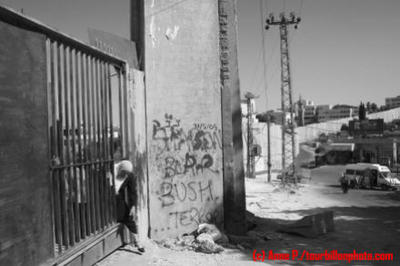 Passage non-officiel entre Abus Dis et Jerusalem sous le regard des soldats/ Non-Official crossing between Abud Dis and Jerusalem, under the eyes of Israeli soldiers.
Passage non-officiel entre Abus Dis et Jerusalem sous le regard des soldats/ Non-Official crossing between Abud Dis and Jerusalem, under the eyes of Israeli soldiers.25 Juillet 2005.
Je suis allée de Bethlehem à Jerusalem en passant par Abu Dis. Normalement on devrait être contrôlé. Abu Dis faisant partie de la Cisjordianie est séparé de Jérusalem. Mais je savais que les Palestiniens passent par un passage dans le Mur, un passage « non-officiel » qui peut être fermé à tout moment. En effet le passage est ouvert et les gens passent entre les barreaux du portail. A ma grande surprise, des soldats israéliens sont là mais ils font passer tout le monde, sans contrôle. Un peu plus loin les gens passent aussi facilement par un autre passage….c’est la même chose avec les barrages, les Palestiniens passent par les côtés, ou par les montagnes. Les soldats le savent très bien. Vraiment s’agit-il de sécurité ou de rendre la vie difficile aux Palestiniens ?
ENGLISH
I wanted to go from Bethlehem to Jerusalem through Abu Dis. Abu Dis is located in the West Bank therefore to go from there to Jerusalem you should be controlled by the Israeli soldiers. But I knew that Palestinians were going from Abu Dis to Jerusalem through a unofficial gate in the Wall, at that place the Wall remains unfinished and you have a gate which can be closed at any time. The Israeli soldiers were there but Palestinians were just going through and there was no control. Also I saw some other crossing that Palestinians were using a little bit further. Thus anybody from the West Bank could then enter Jerusalem. It is the same with many checkpoints, Palestinians can avoid them by going through the mountains, sometimes just by walking a few meters away from the checkpoint. The soldiers know it well. So is it really about security or about making life impossible for Palestinians.
Wednesday, July 20, 2005
de l'universite a de nouvelles funerailles..ainsi va la vie en Palestine/ From university to funerals...so is the life in Palestine


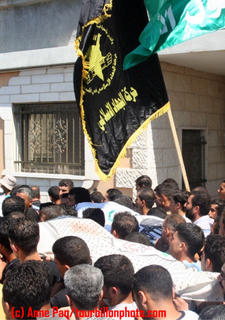 Mercredi 20 Juillet, Universite arabe-americaine de Jenine,
Mercredi 20 Juillet, Universite arabe-americaine de Jenine,Le temps s’accelere et j’ai du mal a tenir mon journal et mes pensees en ordre. Ces quelques derniers jours ont ete tres intenses. Je suis retournée a Al-Aqaba, un tout petit village dans un cadre magnifique qui a reçu plusieurs avis de demolitions, notamment pour le jardin d’enfant et la Mosquée. Le cas doit passer a la cour supreme dans les prochains mois. Le maire Had Sami, handicapé, est admirable par sa volonté de se battre pour son village. J’ai aussi fait des interviews avec des etudiants. On a parlé de leur vie, de leur difficulté, de leurs espoirs. Comme tous les etudiants ils veulent construire un avenir, avoir un bon travail ; fonder une famille. Beaucoup de similitudes chez eux. Tout d’abord la valeur qu’ils accordent a l’education : « Mon education est mon moyen de resister », ' mon stylo est mon arme'. Tous travaillent dur pour reussir. Aussi j’ai été frappée par leur amour profond de la Palestine. La plupart d’entre eux veulent rester ; malgré les difficultés. Enfin, et cela est plus triste, ils ont tous perdu foi en une solution politique, et dans la communauté internationale. L’Intifada va continuer selon eux et la paix n’est pas possible. Comment leur redonner espoir ? Mais peu importe l’avenir- ils ont la volonté de rester et de construire une vie meilleure. Tous ont des histoires tragiques, d’amis perdus, de membres de famille emprisonnés, d’invasion de leur maison par les soldats. Ils savent que tout peut basculer et que l’université n’est pas un sanctuaire.
Au cours d’un entretien avec deux etudiants Mohammad et Rami originaire d’un petit village pres de Jenine, un etudiant a fait irruption pour nous dire que deux jeunes de Yamoun, un village pres de Jenine, ont été tué ce matin par l’armée israélienne. Ils etaient des leaders mocaux des brigades de Al-Aqsa. Les deux jeunes se proposent de m’accompagner. Ainsi va la vie en Palestine. Toujours quelque chose se passe qui interrompt la vie quotidienne. Nous arrivons au village lors de la procession pour les martyrs. Ils sont portés par une foule en colere. Il y a beaucoup de tirs et de larmes. Les corps sont recouvert d’un drap, un deux a été transpercé par le sang qui est maintenant seché. Le moment le plus terrible est lorsque les corps arrivent à l’entrée du cimetière où sont massées les femmes. C’est ici qu’elles vont leur dire un dernier adieu. A travers le zoom de la camera, je decouvre avec horreur les visages tuméfiés, recomposés des martyrs. L’opération militaire a eu lieu dans la matinée. L’armée a encerclé la maison où etaient les deux hommes recherchés, ont coupé des arbres pour dégager la zone et ont commencé à détruire au bulldozer la maison. Un des hommes a tenté de s’enfuir et a été abattu de plusieurs balles dans la tête et le corps. L’autre a péri dans la maison. Morts atroces. Est-ce cela le respect de la trève par Israël ?
Nous passons à la maison détruite, les gens tiennent à me montrer le sang séché où Warrad est mort. Il reste même des morceaux de son crâne. Le soir je vais visiter le village des etudiants. Je reste avec la famille de l’un d’entre eux en toute simplicité. Je passe du bon temps avec les étudiants qui adorent leur village et je peux comprendre pourquoi. Mais j’ai du mal à dormir ce soir là.
ENGLISH
Time is going very fast and have problems to put in order feelings and ideas. Those last days have been very intense. I went to visit a small village on which I was working on last year. Al Aqaba is a beautiful village surrounded by mountains. It has faced many problems in the past because it was in the middle of a military training field. Now the training stopped but problems and threat to its existence continues, through intimidation acts or demolitions orders. The newly built kindergarten and Mosque are now threatened and the case will be brought in front of the Israeli Supreme Court. Hadj Sami, the mayor of the village, is determined to fight for his village.
The next following two days I conducted a serie of interviews with some students of the university. It was very interesting and I was quite moved by some of them. All have their tragic stories to tell, members of family killed or arrested, humiliations at checkpoints, invasions of their homes. They feel not safe at the university and know that everything can rapidly change, for the worse. “My way to resist is my education”, “my weapon is my pen”. Education is considered as the most important thing for them. They are determined to success despite of everything and work very hard. They do not know what the future holds for them but they will try their best. I was especially struck by their love of their country. But also so sad to see that they have no hope for a change and especially do not trust the international community. Who can blame them?
During an interview with two students Mohammad and Ramzy that come from the same village, another student interrupted us to tell us that two members of Al-Aqsa have been killed by the Israeli army in Yamoun, a nearby village. Here is the life in Palestine. Always something comes up to interrupt the daily life. The two students offered me to accompany me in Yamoun. We arrived in the village during the funerals procession. The two bodies were carried by the angry crowed. Men were shooting in the air, while the women standing on the roofs and balconies were crying. One of the sheet that was covering the body was stained with blood. The two martyrs were killed in a very bad way. The Israeli army surrounded the house they were hiding in, destroyed some trees to clear the area and bulldozed the house. One of them Warrad tried to escape and was shot different times in the head and bodies, while Ibrahim was killed in the house. Is that how Israel respects the truce?
The most terrible moment was when the bodies arrived at the entrance of the cemetery where the women of the two families were all waiting to say a last goodbye. They uncovered the sheet and through my camera I discovered with horror the recomposed and swollen faces. The women were shouting and crying.
Then we went to visit the destroyed house and the people took me to see the blood on the floor indicated where Warrad died. There were still some pieces of his skull. I spent the night in the village of the students with their families. People were so nice and the students loved their village. I could understand why. We had a nice time but still I could not sleep very well that night.
de Jenine/From Jenine
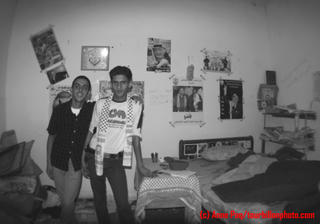

19 Juillet 2005
Etudiants de l'universite arab-americaine de Jenine au cafe de l'universite (photo3) et photo de la lune prise au village de Ramzi et Mohammaddans leur village de Anza (photo 1 et 2) ou ils m'ont invitee.
Students from the Arab-American university of Jenine in the coffee shop (photo 3) and picture pf the moon taken in the village of Mohammad and Ramzy (picture 2) where they invited me.
Sunday, July 17, 2005
Photos des ruines de Jenine/ pics from the ruins of Jenine
Photos des ruines de Jenine/ pics from the ruins of Jenine
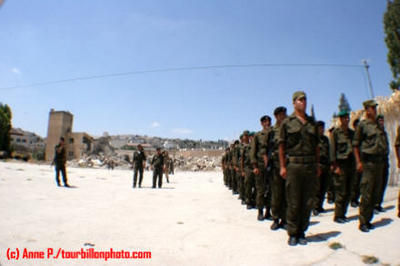
16 Juillet 2005
Tour à Jenine, la aussi je retourne sur mes traces. Je suis accompagnée de Véronique une volontaire qui a travaillé pendant deux ans à Zabadheh. On peut sentir que c’est une bonne personne qui a fait du bon travail ici. Sur le chemin du camp nous nous arrêtons au camp de militaire, autrefois occupé par les britanniques, puis les jordaniens et enfin les Israéliens. Détruit par des bombardements lors de l’Opération Defensive Shield, aujourd’hui occupé par les forces de sécurité palestiniennes. Après négociations, nous rentrons et les soldats effectuent pour nous une demonstration, devant les ruines des batiments. Apparemment ils doivent dormir dans les cellules de l’ancienne prison et ils n’ont pas les moyens necessaires pour renover les batiments. Cela est revelateur de l’etat general de l’Autorite Palestinienne.
Puis nous allons dans le camp de refugies, pleins de maisons ont ete reconstruites sur ce qui etait appele le ground zero (un espace ou plus d’une centaine de maisons avaient ete detruites au bulldozer durant l’operation Defensive shield de 2002, laissant un large espace plat et vide au milieu de camp et des centaines de Palestiniens a la rue) mais ce n’ est toujours pas assez et le camp est surpeuplé.
ENGLISH
I went to Jenine, I wanted to see the changes there. First we stopped at the Muquata; the military camp that was first used by the British, then the Jordanians then the Israelis and finally the Palestinians. The buoldings were mostly destroyed by the Israelis during Operation defensive shield. The soldiers let us in and yes the place is in rumbles. The Palestinian security guards proudly made a special training for us. In front of the ruins that was quite a strange scene and is quiet revealing about the state of the Palestinian autority. Not enough money to rehabilitate the buildings; some soldiers even sleep in what was used as a prison by Israelis!
Then we went to the refugees camp. What was used to be called “the Jenine ground zero” (more than 100 hundreds houses were bulldozed by the Israelis during operation defensive shield; leaving a huge flat empty space in the middle of the camp and hundreds homeless) has been recently replaced by new houses. But the camp still lack places and facilities. Some ruins remain.
Photos de l universite arabe-americaine de Jenine- Pics from Arab-American university- Jenine


J’ai quitté ramallah pour le Nord de la Cisjordanie, dans la egion de Jenine a Zabadheh et l’universite arabe americaine.
Etonnant de voir ce campus moderne au milieu des montagnes. Il y a un restaurant, des espaces verts. Je reste au batiment universitaire des filles. Les filles dans les couloirs ecoutent de la musique, cuisinent, rigolent. Je discute avec deux etudiantes. Elles sont franches, elles n’aiment pas rester ici. Apparemment elles ont du mal avec les autres filles. Differentes mentalités coexistent ici car les etudiantes viennent de partout en Palestine.
Par exemple, elles sont regardées de travers car elles fument. Plus tard une autre fille de Jerusalem m’avoue aussi que c’est dur pour elle car elle avait l’habitude de sortir tous les soirs. Ici il faut etre rentrées a 21h et la gardienne fait la ronde pour verifier aue toutes les filles sont bien la. Une des filles veut aller en Allemagne, un autre etudiant m’affirme lui qu’il compte rester en Palestine car c’est important que les gens restent ici., meme si la vie est difficile.
Sur une note plus generale, les evenements de cette semaine sont assez inquietants. La region de Tulkarem est fermée et les militaires Israéliens y conduisent des opérations. Le Hamas va surment riposter aux assassinats de certains de ses militants ; Israel se prépare à une opération militaire à Gaza. Les gens s’attendent au pire.
ENGLISH
I have moved on to the North of the West Bank in the Jenine area. I stay in the Arab-American University of Jenine. This is rather strange to find such a modern campus in the middle of nowehere. The university is located near the village of Zabadeh, on top of hills. This is quite a nice campus with coffee shops, cafeteria and trees. I stayed in the girls’dorm. All the girls must be in at 9pm. I have met and discussed with a few students. Some girls did not really like the mentality of others. They have problems to adjust as they used to go out. Also the fact that they smoke is a problem. Jenine is quite conservative, there is no comparison with Ramallah. One of the student is tired of the place and wants to go to Germany. Another student told me that he will never leave Palestine, even if it will be very difficult to find a job there.
On a more general note, the events these last week are quite worrying. Tulkarem area is sealed off, surely Hamas will retaliate to the assassinations of some of its militants and Israeli prepares itself to a massive military operation in Gaza. People are not optimistic and prepare themselves for the worse.
Tuesday, July 12, 2005
photos des funerailles d'un jeune palestinien/pics from funerals from a young Palestinian

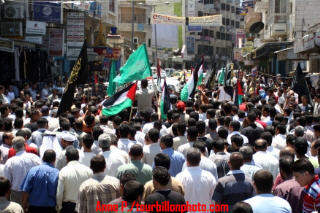


Funerailles d'un Jeune Palestinien de 15 ans tue par balles par un garde israelien lors d'une manifestation contre le Mur le 8 juillet 2005.
Voir texte dans blog precedent.
Funerals of a 15-year old Palestinian killed by an Israeli guard during a demonstration against the Wall.
See text in previous blog
Sunday, July 10, 2005
Un an apres....A year after
10 Juillet 2005
Triste anniversaire que celui-ci: il y a un an la Cour internationale de Justice rendait son avis sur l’illégalité de la construction du Mur dans les territoires occupes palestiniens …un an apres, le Mur continue à être construit et cette semaine a même été decidee l’acceleration de sa construction notamment à Jerusalem Est. 55,000 résidents de Jérusalem Est vont être affectés , vont se retrouver de l’autre côté du Mur et vont être ainsi coupés des services sociaux, de leurs ecoles, lieux de travail, etc.
Un an après la mobilisation contre le Mur s’est écroulée ; la communauté internationale ferme les yeux…pas un article dans les journaux sur cet anniversaire. Triste anniversaire en Palestine, le jour même de l’anniversaire de l’Avis de la Cour, j’assiste aux funérailles d’un jeune de 15 ans, tué par balle par un garde israélien de sécurité lors d’une manifestation contre le Mur. De sang froid. Je peux comprendre la colere et la frustration. Le corps a d’abord ete montré à Ramallah, puis nous sommes allés dans le village du jeune. Tout le monde etait dans la rue pour le pleurer. Le moment le plus triste a été lorsque nous sommes arrives dans sa maison et que toutes les femmes attendaient, en pleurant. Les jeunes etaient particulièrement presents lors des funerailles ; des enfants portant le portrait du jeune et ils etaient tellement nombreux au cimetiere, brandissant drapeaux du Hamas, du Jihad…la violence ne peut nourrir que la violence. Plus de 600 enfants palestiniens tués depuis le debut de la deuxieme Intifada ; pas un soldat inculpé et condamné.
ENGLISH
What a sad anniversary today. One year after the ruling of the International Court of Justice on the illegality of the construction of the Wall in the Occupied Palestinian Territories; the Wall continues to be built and the international community fails to fulfil its obligations to stop Israeli violations of international law. This week the Israeli government has even decided to speed up the construction, especially around Jerusalem. 55,000 Palestinian residents of Jerusalem will be affected and will find themselves on the other side of the Wall, therefore being cut from their basic services, schools, universities, jobs, etc.
One year after, international mobilisation against the Wall has collapsed and the international community closes their eyes to what is happening here. Did you see one article in mainstream media about the anniversary?
A sad day in Palestine; just on the day of the anniversary I went to the funeral of a 15-year old teenager that was shot dead by an Israeli guard in a demonstration the day before. An angry crowd first carried the body in Ramallah, then we all went to the village of the boy, through the mountains to avoid checkpoints. Everybody was out in the streets. The saddest moment was when we reached his home where all the women were waiting for the body, crying. Many young Palestinian and children were at the funeral all along and then to the cemetery, carrying portrait of the new martyr and flags of Hamas and Jihad Islamic…Violence can only increase violence and anger. More than 600 Palestinian children were killed since the beginning of the Second Intifada. Not a soldier was charged and condemned.
Triste anniversaire que celui-ci: il y a un an la Cour internationale de Justice rendait son avis sur l’illégalité de la construction du Mur dans les territoires occupes palestiniens …un an apres, le Mur continue à être construit et cette semaine a même été decidee l’acceleration de sa construction notamment à Jerusalem Est. 55,000 résidents de Jérusalem Est vont être affectés , vont se retrouver de l’autre côté du Mur et vont être ainsi coupés des services sociaux, de leurs ecoles, lieux de travail, etc.
Un an après la mobilisation contre le Mur s’est écroulée ; la communauté internationale ferme les yeux…pas un article dans les journaux sur cet anniversaire. Triste anniversaire en Palestine, le jour même de l’anniversaire de l’Avis de la Cour, j’assiste aux funérailles d’un jeune de 15 ans, tué par balle par un garde israélien de sécurité lors d’une manifestation contre le Mur. De sang froid. Je peux comprendre la colere et la frustration. Le corps a d’abord ete montré à Ramallah, puis nous sommes allés dans le village du jeune. Tout le monde etait dans la rue pour le pleurer. Le moment le plus triste a été lorsque nous sommes arrives dans sa maison et que toutes les femmes attendaient, en pleurant. Les jeunes etaient particulièrement presents lors des funerailles ; des enfants portant le portrait du jeune et ils etaient tellement nombreux au cimetiere, brandissant drapeaux du Hamas, du Jihad…la violence ne peut nourrir que la violence. Plus de 600 enfants palestiniens tués depuis le debut de la deuxieme Intifada ; pas un soldat inculpé et condamné.
ENGLISH
What a sad anniversary today. One year after the ruling of the International Court of Justice on the illegality of the construction of the Wall in the Occupied Palestinian Territories; the Wall continues to be built and the international community fails to fulfil its obligations to stop Israeli violations of international law. This week the Israeli government has even decided to speed up the construction, especially around Jerusalem. 55,000 Palestinian residents of Jerusalem will be affected and will find themselves on the other side of the Wall, therefore being cut from their basic services, schools, universities, jobs, etc.
One year after, international mobilisation against the Wall has collapsed and the international community closes their eyes to what is happening here. Did you see one article in mainstream media about the anniversary?
A sad day in Palestine; just on the day of the anniversary I went to the funeral of a 15-year old teenager that was shot dead by an Israeli guard in a demonstration the day before. An angry crowd first carried the body in Ramallah, then we all went to the village of the boy, through the mountains to avoid checkpoints. Everybody was out in the streets. The saddest moment was when we reached his home where all the women were waiting for the body, crying. Many young Palestinian and children were at the funeral all along and then to the cemetery, carrying portrait of the new martyr and flags of Hamas and Jihad Islamic…Violence can only increase violence and anger. More than 600 Palestinian children were killed since the beginning of the Second Intifada. Not a soldier was charged and condemned.
Saturday, July 09, 2005
photos d'une manif a Bi'lin contre le Mur/ Pics from a demonstration in Bi'lin against the Wall
Des habitants de Bi'lin prennent tranquillement le the dans leur jardin pendant que des jeunes jettent des pierres dans leur jardin/ Inhabitants from Bi'lin drinking tea while the youths are throwing stones from their garden.
Uilisee durant la manifestation/ Used by Israeli soldiers during the demonstration.
 Enfant regardant les jeunes jetes des pierre derriere sa maison, entouree de jeunes et de soldats. J ai ete coincee la un petit moment.
Enfant regardant les jeunes jetes des pierre derriere sa maison, entouree de jeunes et de soldats. J ai ete coincee la un petit moment./ Child looking at Young Palestinians throwing stones at the back of his house surrounded by young Palestinians and soldiers. I was stuck there for a while.
Quel age peut avoir ce soldat israelien?/ How old can be that Israeli soldier?
pics d'une manif a Bi'lin contre le Mur/ Pics from a demonstration in Bi'lin against the Wall
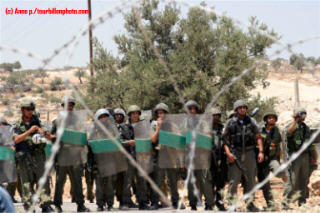
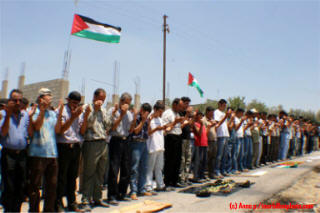
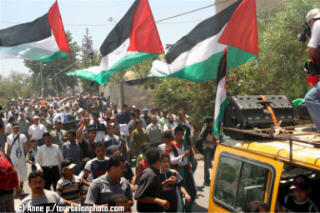
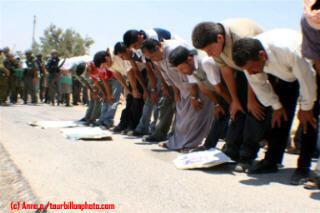
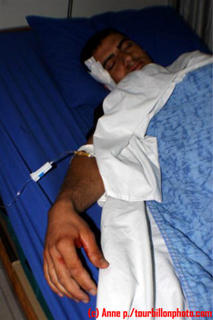 8 Juillet.
8 Juillet.photos d'une manifestation contre le Mur a Bi'lin un petit village a l'ouest de Ramallah. Le village est le theatre de nombreuses manifestations depuis des semaines, les habitants ont deja perdu beaucoup de leur terres. la semaine derniere la manifestation a ete tres violemment reprimee. Hier, les soldats ont fait preuve de plus de retenue surment a cause de la presence de personnalites. Il y avait des representants de differents groupes, des internationaux aussi dont des Israeliens.
nous nous sommes rendus pres de la constrution du Mur, les Palestiniens ont prie dignement. mais ensuite des pierres ont ete lancees sur les soldats par les jeunes du village, la reponse ne s'est pas fait attendre, les manifestants se sont vite disperses, puis les soldats ont charge. a la fin de la manifestation, plus d'une dizaine de blesses. le jeune sur la photo a 24 ans et a ete frappe par une balle en caoutchou, heureusement la balle a evite de justesse son oeil, un autre jeune a ete opere, la balle en caoutchou etant rentree dans son estomac.
Partout en Palestine il y a des manifestations, et la plupart du temps la maniere dont elles sont reprimees est totalement disproportionnee et illegale (usage disproportionne de la force contre des civils). Aller manifester ici c'est prendre un risque enorme, et beaucoup de Palestiniens n'en sortent pas indemnes. Pourquoi ne parle-t-on pas dans les medias de cette resistance la?
ENGLISH.
Pictures from a demonstration in Bi'lin, a small village west of Ramalla. The demonstration was against the construction of the Wall. For months now there have been demonstrations and last week it has been brutally repressed ans some people were arrested, including internationals. Yesterday the soldiers were less brutal, notably due to the presence of several personnalities, but still more than 10 people were injured. the demonstrations included representatives from different groups, and also some internationals, including Israelis.
We went down to the construction site of the Wall, where the soldiers were waiting for us. Palestinians began to pray, it was a very strange scene to witness. Then the youths of the villages started to throw a few stones to soldiers. and of course the soldiers started to charge and throw gaz. then most demonstrators left and the battle began between the youth and the soldiers. At the end more than ten were injured. The young Palestinian on the picture was hit by a rubber bullet and was lucky enough that it missed his eye. Another one had to be opereated because the rubber bullet went into his body.
Everywhere in Palestine, there are some demonstrations. Most of the time they are brutally repressed, in a disproportionate way. Such acts are illegal because it targets civilians. Going to demonstrate has become very dangerous and many Palestinians are injured, or arrested during such demonstrations. Why do the media stay silent?
Thursday, July 07, 2005
Le Checkpoint de Qalandia...le nouveau terninal est en marche/ Qalandia checkpoint...buliding of the new terminal




Ceux qui connaissent le checkpoint de qalandia verront a quel point les choses sont en train de changer rapidement. le Mur avance ainsi que la construction du Terminal (photo 1 et 4) qui devrait etre en etat de marche dans les prochaines semaines et va encore renforcer l'isolemement de la Cisjordanie. Qalandia est le principal checkpoint de Cisjordanie et separe Ramallah de Jerusalem. De nombreux Palestiniens y perdent des heures entieres et y subissent des humiliations quotidiennes/
Those who know Qalandia checkpoint can see all the changes that have occurred this last year. The Wall continues to be built, now in the other side (picture 4) and also the new terninal is rapidly built and should work in the upcoming months, therefore aggravating the isolation of the West Bank. Qalandia is the main checkpoint of the West Bank and separates Ramallah from Jerusalem. Palestinian people are losing hours and are humiliated there everyday.
Pics from Shufat
Du camp de Shufat: Le Mur continue et affecte aussi les refugies...From Shufat: The Wall continues and affects refugees
5 Juillet 2005
J'ai decide d'aller visiter le camp de refugies de Shufat au nord Est de Jerusalem.
Le camp est tres pauvre et surpeuple, officiellement ils sont il y a des enfants partout qui se font tres pressants autour de l'appareil photo. Je suis venue car je sais que le Mur va commence a etre construit ici et effectivement quand j'arrive les enormes caterpillars etaient en train de creuser. Le Mur va separer le camp des colonies qui sont si proches, mais va ainsi separer le camp de refugie de Jerusalem. Or la plupart de srefugues sont inscrits a Jerusalem dont ils dependent pour de nombreux services (ironie, ils payent meme des impots aux Israeliens pour ces services!).
J'ai ete invitee par une des familles dont la maison a recu un avis de demolition car elle est adjacente au trace du Mur. Plus d'une centaine de maisons seraient menaces. Si elles sont detruites ou iront les habitants alors que le camp est deja surpeuple?
La famille m'invite a visiter la maison et les travaix qu'ils effectuent pour l'agrandir. Ils sont huit enfants donc dix en tout. Je partage un repas. Les soldats sont en Presque en permanence postes a cote de la maison et on peut voir la jeep de la fenetre d'une des chambre des enfants. Tout a coup une jeep militaire passe a fond devant nous et nous entendons des tirs alors que tout le quartier regorge d'enfants. Ces tirs ne sont pas a quelques km mais bien a quelques metres. Je ne peux m'empecher de sursauter tandis que les enfants autour de moi ne reagissent absolument pas. Le bebe continue a jouer avec le peigne, les autres a rire.
Cela en dit beaucoup. Leur absence de reaction n'est pas rassurante mais au contraire elle est terrifiante.
Ps: Le 9 Juillet, un an pres l'avis de la Cour internationale de Justice declarant le Mur dans son trace comme illegal: mobilisation mondiale contre le Mur. Mobilisons nous, boycottons les produits israeliens (et les companies qui soutiennent l'occupation comme caterpillars)!
ENGLISH
Yesterday I went to visit the Shufat refugees camp, north Eeast of Jerusalem, because I heard that the Israelis are going to build the Wall there. And indeed, the caterpillars are starting doing their job, digging just a few meters from some houses of the camp. The settlements are just on the opposite side, so close to the camp.
The camp is overcrowded; the alleys are so narrow that one can barely see the sunlight. Poverty is everywhere and garbage are not taken away, due to the failure of the municipality to provide basic services to the camp. The children are all over and run after me to have one picture taken. What can they do during their two months vacations?
The Shufat camp is located within the boundaries of the municipality of Jerusalem, therefore the residents of the camp heavily depend on services from Jerusalem (ironically they pay taxes to the Israelis). Once the Wall will be built, their situation will therefore dramatically deteriorate. Furthermore many houses have received demolition orders and one can wonder where the people will go as the camp is already so overcrowded. I am invited to one of these houses. The family is lovely. They are ten living in just a few rooms so they have started to expand the house. They were desperate to receive the demolition order. Absence of permit was used as an excuse but the real reason is that the house is located just next to the route of the Wall. From the room of some of the children we could see a military jeep, standing there almost permanently. And once we started eating, a military jeep rushed into the street full of children and soon there were shootings. I mean not a few kms away but just a few meters. I could not help shuddering but what amazed me is that the baby still played and the children just continued to laugh. This tells a lot. Their absence of reaction is far from being reinsuring but rather terrifying.
Ps: On the 9 of July, one year after the ICJ released its advisory opinion on the Wall and declared it illegal in its route, there will be a world-wide mobilization against the Wall.
Take action, boycott Israeli goods and also the campanies such as caterpillar which support the occupation!
J'ai decide d'aller visiter le camp de refugies de Shufat au nord Est de Jerusalem.
Le camp est tres pauvre et surpeuple, officiellement ils sont il y a des enfants partout qui se font tres pressants autour de l'appareil photo. Je suis venue car je sais que le Mur va commence a etre construit ici et effectivement quand j'arrive les enormes caterpillars etaient en train de creuser. Le Mur va separer le camp des colonies qui sont si proches, mais va ainsi separer le camp de refugie de Jerusalem. Or la plupart de srefugues sont inscrits a Jerusalem dont ils dependent pour de nombreux services (ironie, ils payent meme des impots aux Israeliens pour ces services!).
J'ai ete invitee par une des familles dont la maison a recu un avis de demolition car elle est adjacente au trace du Mur. Plus d'une centaine de maisons seraient menaces. Si elles sont detruites ou iront les habitants alors que le camp est deja surpeuple?
La famille m'invite a visiter la maison et les travaix qu'ils effectuent pour l'agrandir. Ils sont huit enfants donc dix en tout. Je partage un repas. Les soldats sont en Presque en permanence postes a cote de la maison et on peut voir la jeep de la fenetre d'une des chambre des enfants. Tout a coup une jeep militaire passe a fond devant nous et nous entendons des tirs alors que tout le quartier regorge d'enfants. Ces tirs ne sont pas a quelques km mais bien a quelques metres. Je ne peux m'empecher de sursauter tandis que les enfants autour de moi ne reagissent absolument pas. Le bebe continue a jouer avec le peigne, les autres a rire.
Cela en dit beaucoup. Leur absence de reaction n'est pas rassurante mais au contraire elle est terrifiante.
Ps: Le 9 Juillet, un an pres l'avis de la Cour internationale de Justice declarant le Mur dans son trace comme illegal: mobilisation mondiale contre le Mur. Mobilisons nous, boycottons les produits israeliens (et les companies qui soutiennent l'occupation comme caterpillars)!
ENGLISH
Yesterday I went to visit the Shufat refugees camp, north Eeast of Jerusalem, because I heard that the Israelis are going to build the Wall there. And indeed, the caterpillars are starting doing their job, digging just a few meters from some houses of the camp. The settlements are just on the opposite side, so close to the camp.
The camp is overcrowded; the alleys are so narrow that one can barely see the sunlight. Poverty is everywhere and garbage are not taken away, due to the failure of the municipality to provide basic services to the camp. The children are all over and run after me to have one picture taken. What can they do during their two months vacations?
The Shufat camp is located within the boundaries of the municipality of Jerusalem, therefore the residents of the camp heavily depend on services from Jerusalem (ironically they pay taxes to the Israelis). Once the Wall will be built, their situation will therefore dramatically deteriorate. Furthermore many houses have received demolition orders and one can wonder where the people will go as the camp is already so overcrowded. I am invited to one of these houses. The family is lovely. They are ten living in just a few rooms so they have started to expand the house. They were desperate to receive the demolition order. Absence of permit was used as an excuse but the real reason is that the house is located just next to the route of the Wall. From the room of some of the children we could see a military jeep, standing there almost permanently. And once we started eating, a military jeep rushed into the street full of children and soon there were shootings. I mean not a few kms away but just a few meters. I could not help shuddering but what amazed me is that the baby still played and the children just continued to laugh. This tells a lot. Their absence of reaction is far from being reinsuring but rather terrifying.
Ps: On the 9 of July, one year after the ICJ released its advisory opinion on the Wall and declared it illegal in its route, there will be a world-wide mobilization against the Wall.
Take action, boycott Israeli goods and also the campanies such as caterpillar which support the occupation!
Tuesday, July 05, 2005
photo on line
Quelques une de mes photos sur le Mur sont publiees sur Baubau: http://www.baubaunet.com/
allez ensuite dans la rubrique search et mettez Anne Paq.
ENGLISH
A few of my pictures have been published on theweb: see Baubau: http://www.baubaunet.com/
then click on search and put the name: anne paq.
allez ensuite dans la rubrique search et mettez Anne Paq.
ENGLISH
A few of my pictures have been published on theweb: see Baubau: http://www.baubaunet.com/
then click on search and put the name: anne paq.
pics de bethlehem
Sunday, July 03, 2005
De l'hotel 5 etoiles au camp de refugies; From 5 stars hotel to refugees camp
3 Juillet 2005 Bethlehem
Droles de trois derniers jours…j’etais invitee dans une conference internationale sur le droit des enfants, plus particulièrement sur les enfants emprisonnes. Ceux qui gravitent dans les relations internationales savent de quoi je veux parler : grande conférence, grandes pointures, tous réunis dans un hotel cinq etoiles – l’intercontinental de Bethlehem, spécialement reouvert pour l’occasion. L’hôtel est magnifique avec son architecture raffinée, ses jardins intérieurs et meme une grande piscine. Etant plus habituée aux auberges de jeunesse, j’avoue que cela était tentant d’en profiter. Toute la situation semblait un peu surréaliste. L’hôtel est situe juste a cote du camp de réfugies de Aida. La vue de ma chambre donnait sur le Mur et le campo de refugies. Cocktail autour de la piscine, profusion de nourriture tandis que quelqu’un me décrivait combien les Palestiniens du camp de réfugies adjacent se ruaient sur la nourriture lors de la distribution des vivres par UNRWA, l’organisation des Nations Unies en charge des réfugies palestiniens, et même fêtes avec danse. J’avais un peu du mal a croire que nous étions en Palestine et alors que nous prenions confortablement notre petit déjeuner, les soldats israéliens étaient entres dans le camp de Deheisha et avaient procede a des fouilles et arrestations, a seulement quelques kilomètres de nous…Comment gérer ces paradoxes ? je ne sais pas mais il faut reconnaitre que cette conférence a été pour certains l’occasion de venir pour la premiere fois en Palestine et qu’il est important que les gens viennent ici et se fassent leur propre opinion en se confrontant a la réalité (encore fallait-il sortir de l’hotel).
Quelquefois la dure réalité faisait irruption, notamment par un documentaire : ‘A stone’s thrown away’ (une pierre lancee) sur un groupe de jeune garcons de 13-14 ans pendant le siege de 2002 du camp de Deheisha. Incursions militaires, couvre feu a répétition, arrets repetes de l’ecole., les jeunes ne peuvent rien faire et bravent le couvre feu et lancent des pierres, non poiur s’amuser mais parce qu’ils se sentent obliges de le faire. Un des jeunes est tue devant son ami Rami. Rami recite le nombre des martyrs qu’il connaît, une longue liste de noms qu’il egrene avec la meme voix grave et monocorde. Il raconte combien l’image d’un jeune tue en pleine tete le poursuit sans cesse. Le pere de Rami etait dans la salle de la projection, il etait cense parler mais etait trop bouleverse pour le faire. Il voulait nous parler de Rami, arrete en Janvier 2005 a l’age de 16 ans. Il est accuse d’avoir produit et tente d’utiliser des explosifs contre l’armee israelienne et risque une sentence, basee sur un ordre militaire, de vingt ans de prison pour des faits qu’il aurait commis a l’age de 14 ans. Sa famille cherche a employer une bonne avocate israélienne pour le defendre devant la cour militaire mais n’ont pas les moyens nécessaires de le faire. (contact : The prisoners society- Bethlehem district).
Vingt ans ! vous avez bien lu….et Rami n’est malheureusement pas un cas isole. Les lumières se rallument, la suite du programme continue mais je n’irai pas au spectacle de danse.
Droles de trois derniers jours…j’etais invitee dans une conference internationale sur le droit des enfants, plus particulièrement sur les enfants emprisonnes. Ceux qui gravitent dans les relations internationales savent de quoi je veux parler : grande conférence, grandes pointures, tous réunis dans un hotel cinq etoiles – l’intercontinental de Bethlehem, spécialement reouvert pour l’occasion. L’hôtel est magnifique avec son architecture raffinée, ses jardins intérieurs et meme une grande piscine. Etant plus habituée aux auberges de jeunesse, j’avoue que cela était tentant d’en profiter. Toute la situation semblait un peu surréaliste. L’hôtel est situe juste a cote du camp de réfugies de Aida. La vue de ma chambre donnait sur le Mur et le campo de refugies. Cocktail autour de la piscine, profusion de nourriture tandis que quelqu’un me décrivait combien les Palestiniens du camp de réfugies adjacent se ruaient sur la nourriture lors de la distribution des vivres par UNRWA, l’organisation des Nations Unies en charge des réfugies palestiniens, et même fêtes avec danse. J’avais un peu du mal a croire que nous étions en Palestine et alors que nous prenions confortablement notre petit déjeuner, les soldats israéliens étaient entres dans le camp de Deheisha et avaient procede a des fouilles et arrestations, a seulement quelques kilomètres de nous…Comment gérer ces paradoxes ? je ne sais pas mais il faut reconnaitre que cette conférence a été pour certains l’occasion de venir pour la premiere fois en Palestine et qu’il est important que les gens viennent ici et se fassent leur propre opinion en se confrontant a la réalité (encore fallait-il sortir de l’hotel).
Quelquefois la dure réalité faisait irruption, notamment par un documentaire : ‘A stone’s thrown away’ (une pierre lancee) sur un groupe de jeune garcons de 13-14 ans pendant le siege de 2002 du camp de Deheisha. Incursions militaires, couvre feu a répétition, arrets repetes de l’ecole., les jeunes ne peuvent rien faire et bravent le couvre feu et lancent des pierres, non poiur s’amuser mais parce qu’ils se sentent obliges de le faire. Un des jeunes est tue devant son ami Rami. Rami recite le nombre des martyrs qu’il connaît, une longue liste de noms qu’il egrene avec la meme voix grave et monocorde. Il raconte combien l’image d’un jeune tue en pleine tete le poursuit sans cesse. Le pere de Rami etait dans la salle de la projection, il etait cense parler mais etait trop bouleverse pour le faire. Il voulait nous parler de Rami, arrete en Janvier 2005 a l’age de 16 ans. Il est accuse d’avoir produit et tente d’utiliser des explosifs contre l’armee israelienne et risque une sentence, basee sur un ordre militaire, de vingt ans de prison pour des faits qu’il aurait commis a l’age de 14 ans. Sa famille cherche a employer une bonne avocate israélienne pour le defendre devant la cour militaire mais n’ont pas les moyens nécessaires de le faire. (contact : The prisoners society- Bethlehem district).
Vingt ans ! vous avez bien lu….et Rami n’est malheureusement pas un cas isole. Les lumières se rallument, la suite du programme continue mais je n’irai pas au spectacle de danse.
ENGLISH
The last three days have been strange. I was invited to a big international conference on Children’rights and more specifically on children behind bars. Those who are working in international relations know those kind of conferences are like, with eminent speakers, all gather into a 5-stars hotel- the Intercontinental hotel from Bethlehem that opens especially and only for the conference. I might say that being more used to youth hostels, I was quite impressed. The hotel is magnificent with a great architecture, patios, gardens, and even a big swimming pool…The situation seemed a little bit surreal under the circumstances and also because the hotel is located just next to Aida Refugee camp. The view of my room was directly on the Wall and on the refugee camp. I just felt on a totally different planet…we had cocktail parties and huge breakfast while someone was telling me about how the Palestinians from the refugee camp were rushing for the food distribution from UNRWA, the UN agency that deals with Palestinian refugees. We even had dancing parties! I could not believe I was in Palestine…but while we were having our breakfast, the Israeli soldiers were entering the Deheisha camp and arrested some people. Just a few kilometers from us and a totally different reality. How to deal with those paradoxes? I am not sure but one has to acknowledge that the conference brought some people from all over the world for the first time in Palestine and that it was symbolically important that such a conference on children behind bars takes place in Palestine while so many Palestinian children have been arrested or are currently in prison,
Sometimes the reality was bumping into the conference such as that very good documentary ‘A Stone’s thrown away’, about a group of friends from 13 to 14 during the siege of Deheisha camp in 2002. Curfews, military incursions, no school…so nothing to do. The kids used to break the curfew and throw stones to the tanks and armored vehicle. One of them was killed by live ammunition in front of his friend Rami. In an interview when asked about how many martyrs he knows, Rami began to say a long list of names with his grave voice. He said how it could not forget the image of one of them when he was shot in the head. Rami’s father was in the room with us and was supposed to talk anoput his son but he was overwhelmed by the emotion and could not speak. He wanted to tell us that Rami was arrested in January 2005 when he was only 16. He is accused of having prepared and attempted to use explosives when he was only 14. He is facing a twenty years sentence, based on a military order. His family is looking assistance to pay a good Israeli lawyer to represent him. (contact : The prisoners society- Bethlehem district).
You read right : twenty years ! He would be judged in a military court. Unfortunately he is not an isolated case. After the documentary the schedule of the conferences continued but I could not go to the dancing show.
Saturday, July 02, 2005
Retour en Palestine/Back to Palestine

Subscribe to:
Posts (Atom)
